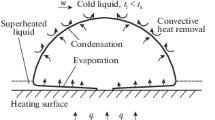Abstract
Stainless steel plate with 30mm in length, 1 mm in width and 0.1 mm in thickness is employed for a heating surface in subcooled quasi-pool boiling of water under low gravity performed by a parabolic flight. Testing liquid subcooling is about 10K at atmospheric pressure. The wetting heating surfaces are coated with ceramics materials which have been developed by a certain glass company. DC power is applied directly into the test heating surface and the bubble behaviors are observed by a high-speed video camera. Contact angle of water droplet is about 77–96 degree for the stainless surface and 30 degree or less for the wetting surface. In the ground experiment, the size of detaching bubbles from the wetting surface is smaller than those of stainless surface and the detaching period is shorter at same heating power. The burnout heat fluxes of wetting surfaces are about 50 percent higher those of stainless surfaces. In the low gravity experiment, DC power is applied into the surface at 10 second before start of low gravity and increases slightly until burnout. A single large bubble grows on the stainless surface and finally, the surface is burned out in a short period. For wetting surface, several large coalescing bubbles appear and they move rapidly on the surface, then one of the large bubbles grows and the burnout occurs. The burnout heat fluxes are higher than those of stainless surface. The wetting ceramics surface is considered to accelerate the liquid supply and the bubble moving.
Similar content being viewed by others
References
Takata, Y., 2003, “Photo-induced Hydrophilicity and It’s Applications to Phase Change Phenomena.” Thermal Science and Engineering, (Heat Transfer Society of Japan), Vol. 10, No. 6, 31–39
Takamasa, T., Hazuku, T., Mishima, K., Okamoto, K., Mitsutake, T. andMorooka, S, 2003,“:Effect of Radiation Induced Surface Activation on Quenching Condition.” Thermal Science and Engineering, (Heat Transfer Society of Japan), Vol. 11, No. 4, 33–41
Abe, T., 2005, “Self-rewetting Fluids-Beneficial Aqueous Solutions.” Proceedings of the Interdisciplinary Transport Phenomena in Microgravity and Space Science Conference IV, CR-ROM, ECI-ITP-05-26
JP Patent 2599531, JP Patent 3147251, JP Patent 3340149
Author information
Authors and Affiliations
Corresponding author
Additional information
Paper was presented on the Second International Topical Team Workshop on TWO-PHASE SYSTEMS FOR GROUND AND SPACE APPLICATIONS October 26–28, 2007, Kyoto, Japan.
Rights and permissions
About this article
Cite this article
Suzuki, K., Ohta, H., Kawamura, H. et al. Bubble behaviors in subcooled boiling of wetting surface under low gravity. Microgravity Sci. Technol 19, 62–63 (2007). https://doi.org/10.1007/BF02915752
Received:
Revised:
Accepted:
Issue Date:
DOI: https://doi.org/10.1007/BF02915752




